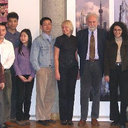Pediatric medulloblastoma xenografts including molecular subgroup 3 and CD133+ and CD15+ cells are sensitive to killing by oncolytic herpes simplex viruses.
キーワード
概要
BACKGROUND
Childhood medulloblastoma is associated with significant morbidity and mortality that is compounded by neurotoxicity for the developing brain caused by current therapies, including surgery, craniospinal radiation, and chemotherapy. Innate therapeutic resistance of some aggressive pediatric medulloblastoma has been attributed to a subpopulation of cells, termed cancer-initiating cells or cancer stemlike cells (CSCs), marked by the surface protein CD133 or CD15. Brain tumors characteristically contain areas of pathophysiologic hypoxia, which has been shown to drive the CSC phenotype leading to heightened invasiveness, angiogenesis, and metastasis. Novel therapies that target medulloblastoma CSCs are needed to improve outcomes and decrease toxicity. We hypothesized that oncolytic engineered herpes simplex virus (oHSV) therapy could effectively infect and kill pediatric medulloblastoma cells, including CSCs marked by CD133 or CD15.
METHODS
Using 4 human pediatric medulloblastoma xenografts, including 3 molecular subgroup 3 tumors, which portend worse patient outcomes, we determined the expression of CD133, CD15, and the primary HSV-1 entry molecule nectin-1 (CD111) by fluorescence activated cell sorting (FACS) analysis. Infectability and cytotoxicity of clinically relevant oHSVs (G207 and M002) were determined in vitro and in vivo by FACS, immunofluorescent staining, cytotoxicity assays, and murine survival studies.
RESULTS
We demonstrate that hypoxia increased the CD133+ cell fraction, while having the opposite effect on CD15 expression. We established that all 4 xenografts, including the CSCs, expressed CD111 and were highly sensitive to killing by G207 or M002.
CONCLUSIONS
Pediatric medulloblastoma, including Group 3 tumors, may be an excellent target for oHSV virotherapy, and a clinical trial in medulloblastoma is warranted.



